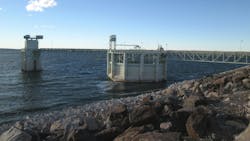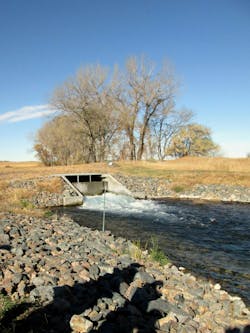Streamlining Nebraska's hydrological data: Faster, smarter and accessible
In water management, the focus is often on the tangible – the flow of rivers, the depth of aquifers, and the inches of rainfall. But equally crucial, yet often overlooked: is how to optimize and use the masses of collected data efficiently. Nebraska's journey to modernize its water data management is not just a tale of one state's trials and triumphs: it is a microcosm of the challenges facing our entire industry.
The high stakes of hydrological data
Nebraska's hydrological landscape is a perfect storm of complexity. From the arid high plains of the west with a mere 13 inches of annual rainfall to the relatively water-rich east with 33 inches, the state is a testament to the diverse water challenges faced across North America. Add to this the vast agricultural lands that rely heavily on irrigation – Nebraska leads the nation in irrigated acres – and you have a recipe for water management that demands precision, reliability, and foresight.
None of this management is possible without robust, reliable data – the lifeblood of decision-making for the Nebraska Department of Natural Resources (NeDNR). The department performs floodplain modeling, mitigation, and warning, so economically speaking it is extremely important to the State.
“The goal is to count every drop, measure every flow, and record every level – it all adds up to the big picture that guides policy, informs agriculture, and, quite literally, keeps the waters flowing through the state,” said Jim Williams, an engineer who has been with NeDNR for 24 years.
The struggle with legacy systems
A few years ago, NeDNR found itself in a situation many dread but few discuss openly – a failing data management system. In 2018, the system was crashing one to two times a week with over 75 system failures in a year. It is not possible to forecast flooding with unreliable data. Consider the implications for water rights management when your system decides to crash. This is not an uncommon situation in the water industry when using legacy software. Fortunately, Jeremy Gehle, Head of Water Administration at NeDNR, reached out to neighboring states and the USGS Water Science Center to find out what programs they were using.
Making the switch to modern software
On recommendations from peers, NeDNR trialed the Aquarius platform on its state servers. The software, designed for water monitoring agencies worldwide, immediately showed promise.
"It worked right from the get-go," Gehle said, highlighting the stark contrast to their previous struggles. “It wasn't just adopting a new tool; it was embracing a new philosophy of water data management.”
The Aquatic Informatics team who developed Aquarius performed a business analysis on-site interviewing key players at NeDNR to map the data migration and better understand its data workflows. Through the three-day process, they uncovered several areas for improvement in their data management workflows.
“Before Aquarius, our data collection process involved roughly fifteen steps before we could use the data,” Williams said. “The new software does it in three. Now our technicians can take a measurement at a stream site, upload the information and apply any necessary shifts, review the rating curve and within a few minutes they can correct all the data going back for the past month or two. So, it's simplified our operations tremendously.”
The new software makes it easier to integrate, import and enter data quickly and securely while storing all information in one central place, making management and reporting more streamlined. It also automates the quality assurance of data providing tools for error detection, data cleaning, data flagging, and automatic bias corrections.
When asked about his favorite features, Williams said “I like the coherent and unified way that I can work with approvals. I can leave comments and notes right on the timeline within Aquarius. It's a very graphical process making it easy to look for information, approvals, grades, quality, etc. All of that information is inherent in the software.”
The transition to the new platform brought benefits in efficiency including:
- Real time data acquisition, processing, and publishing.
- Streamlining data management by centralizing data storage, making information retrieval quick and easy.
- Automated data quality checks with error detection, data cleaning, flagging, and automatic bias corrections. This automation drastically reduces the time spent on manual data verification, allowing hydrologists to focus on analysis and decision-making.
- Consolidation of various data management tasks into a single platform eliminates the need to switch between multiple systems. This integration streamlines workflows, saving time and reducing the potential for errors.
- A user-friendly interface making data entry more efficient and reporting quicker with access to any information needed in one central location.
“One of the greatest advantages, in my opinion, is having the support desk with the ability to ticket the information and know that somebody is going to get back to you within a few hours, or if it's not critical, within a day or two. And they're usually very good at solving the issue,” Williams said.
Most important is the shift from reactive to proactive management. With reliable, accessible data, NeDNR's hydrologists can focus on analysis, community outreach, and forward-thinking decision-making.
A new era of efficiency
This shift to a modern data management platform has not only saved NeDNR time but also enhanced the department's ability to serve its stakeholders and make informed decisions about Nebraska's vital water resources. In an era where efficient data management is crucial for environmental stewardship and resource allocation, NeDNR's experience demonstrates the profound impact that the right software solution can have on an organization's effectiveness and the communities it serves. In a state where water is a critical resource for agriculture, and is subject to extreme events like flooding, quickly processing and disseminating accurate data is invaluable.
Nebraska's story is not unique. Across the country, water management agencies are grappling with outdated systems, data silos, and the ever-increasing demands of a water-stressed world. Climate change is not just altering our precipitation patterns; it's changing the very nature of our work. We need to be faster, smarter, and more accessible than ever before.
About the Author
Everett Adams
Everett Adams is an Account Executive with Aquatic Informatics. He is a software as a service (SaaS) veteran with an emphasis on data management and compliance in the water industry.




